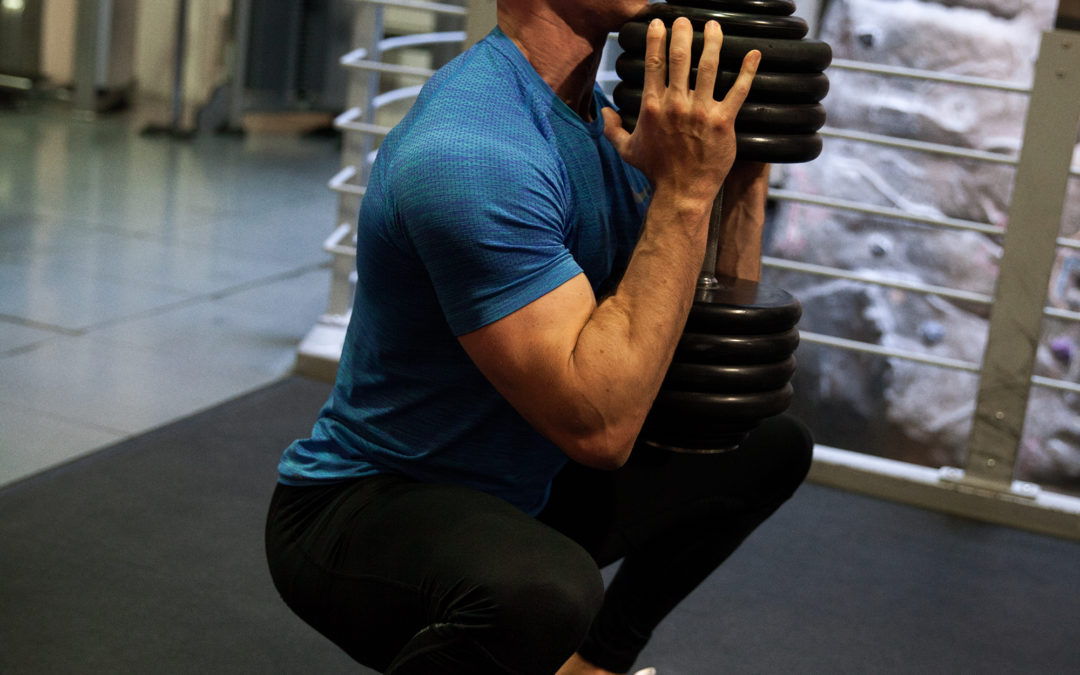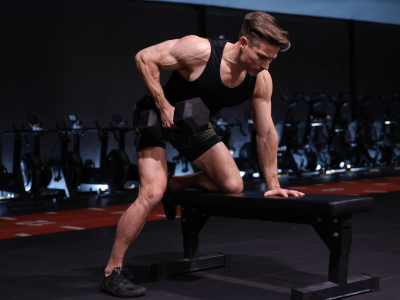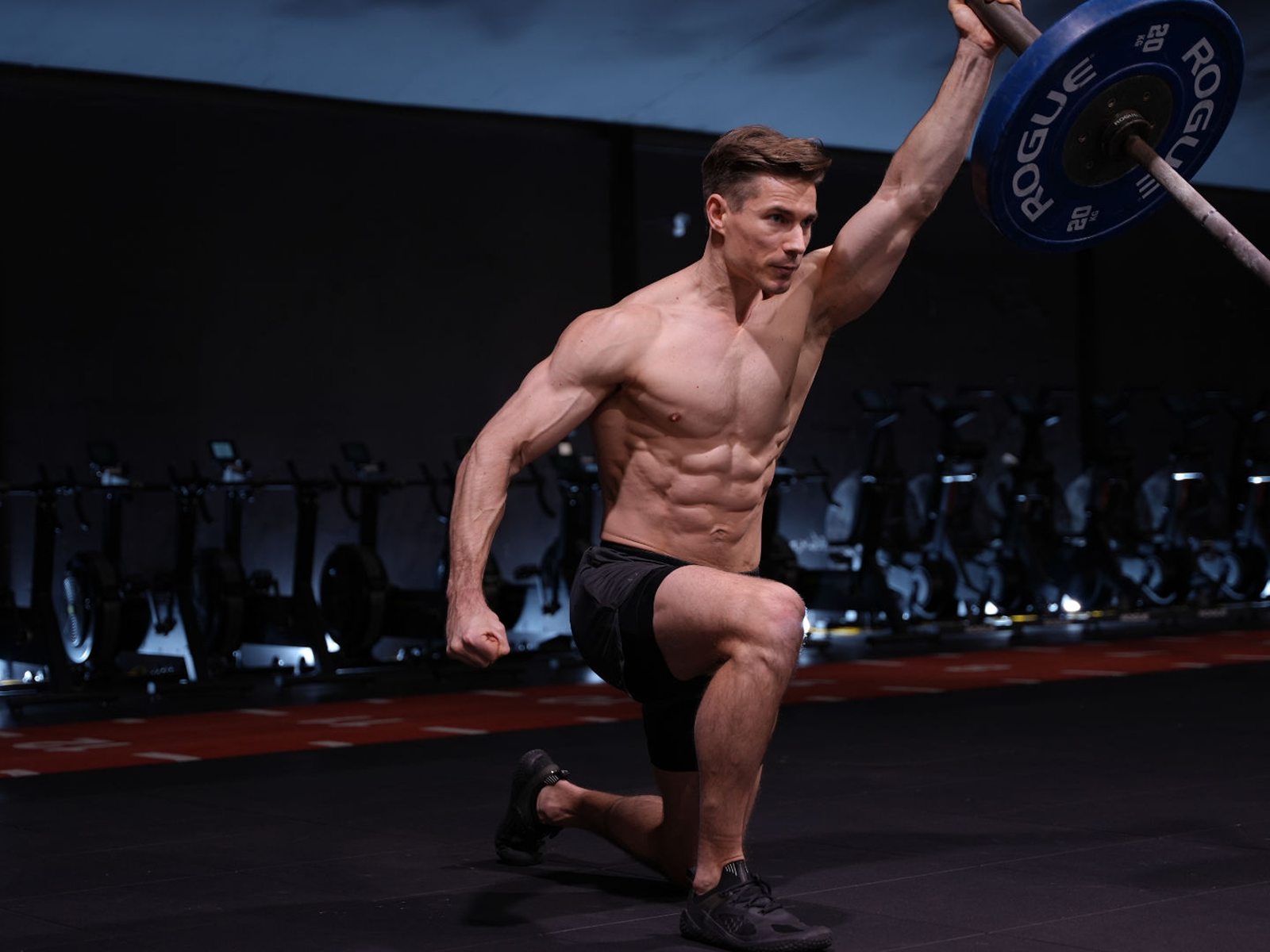Squats might be considered the king of lower body exercises, but here’s the reality – most people don’t squat well, least not under a barbell. Whether it’s mobility restrictions or pain complains of the shoulders, hips and knees, there’s usually at least one reason why this is often the case.
Enter – The Goblet Squat.
Goblet squats – which involve holding a weight against the chest – might be regarded by the masses as an exercise for newbies, but this notion couldn’t be further from the truth. World class strength coaches like Dan John and Mike Boyle have been championing them for years and they are a prominent feature in the programming of many profession athletes, worldwide. So whether you’re new to lifting or built like a brick shit house, goblet squats deserve a firm place in your squat arsenal. Not convinced? Here’s 5 reasons why:
5 Benefits of Goblet Squats
#1 Master Proper Squatting Mechanics
Many people don’t squat well with a barbell because they struggle to create whole body tension. But when you hold a weight against the front of the body – you don’t have a choice. The posterior chain and core musculature switch on almost reflexively to keep an upright torso and prevent you from falling forward.
That front sided load also allows you to drop the hips while maintaining good posture…rather than turn the movement into a squatty goodmorning hybrid which is often the case.
So the goblet squat allows most everyone to load up the squat pattern and get a great training effect. It also teaches the importance of ‘getting tight’ which is a necessity for anyone who wants to build a bigger, stronger squat.
#2 Squat Pain Free
Goblet squats are a very joint friendly exercise. You do not need to load anywhere near as heavy as a back squat to get a decent training effect, resulting in less compressive forces through the spine, hips and knees. They are also very kind to the shoulders which is a major win if yours are a little beat up or lack the mobility to grab a barbell behind your head. All of these reasons are highly favourable for lifting longevity.
#3 Build Functional Strength & Muscle
Goblet squats are more than a teaching tool to learn proper squatting mechanics. They strongly engage the core and spinal erectors which keep the torso upright and aide in lumbopelvic stability. The glutes are loaded through a full range of motion and the quads are blasted hard as they work to track the knees over the toes and fire the hips up out of the hole. Your body has to work as a complete unit to coordinate an efficient goblet squat. They pack a powerful punch and will leave you gasping for breathe after each set (probably why most people are afraid of them, just like front squats lol)
#4 Bulletproof Core.
You cannot perform a goblet squat with a sloppy mid section, you’ll simply drop the weight or fall flat on your face! The core has to work hard to keep the torso upright, the spine rigid and maintain lumbopelvic stability throughout the motion. If you’re new to this exercise – expect a serious case of ab DOM’s the next day! They will build core strength FAST.
#5 Mobility Gains
Its all well and good performing heavy barbell squats to parallel. But for long term joint health and the maintenance of mobility, this is not ideal. Our joints depends on movement to function well and we need to build strength across all of our ranges to maintain mobility. Goblet squats allow most people to squat deep – which is great for hip, knee and ankle joint health & mobility.
Variations & Progressions
In this section, I’ve laid out 4 goblet squat variations.
Variation is good.
When you switch from one similar exercise to another, muscle fibre recruitment changes and you offset the risk of repetitive strain injuries that can occur from hammering the exact same lines of tension.
Variation is beneficial from a results standpoint, lifting longevity and also to keep training interesting. But this is also a logical progression to the barbell, if that’s your aim.
#1 Landmine Goblet Box Squat
Using the landmine has some additional benefits over dumbbells. The arcing bar path forces you to sit back while keeping the torso upright – so its an excellent teaching tool. By the same token, it’s the most joint friendly goblet squat variation – very easy on the low back and knees. Using a box helps to gauge depth and keep each rep consistent. This will improve one’s ability to maintain a neutral spine at the bottom of the squat and switch form a controlled descend to an explosive drive back up to standing.
Coaching Notes
- Either have a partner pass you the bar, or ‘clean’ it up as demonstrated in the video.
- Hands should be interlaced with the palms of your hands pressed together underneath.
- Adopt a slight forward lean into the bar to allow for the ‘arc’ that will force the hips back.
- Stabilise the hips by bracing the abs in a neutral spine position.
- Drop the hips back and down, while keeping the torso erect.
- When you touch the bench with your butt, fire the hips up by pressing the soles of your feet firmly down.
#2 Landmine Goblet Squat
Similar to Landmine Box Squats, only without the box (Read that description to understand the benefits of the landmine). This allows you descend deeper, which requires greater levels of mobility and stability. Side note: I personally love to program this exercise on secondary leg day. It’s a great way to increase ‘squat volume’ without beating up the joints.
Coaching Notes
- Place the bar on a box or bench at the low point of your squat.
- Hands should be interlaced with the palms of your hands pressed together underneath.
- Adopt a slight forward lean into the bar to allow for the ‘arc’ that will force the hips back.
- Stabilise the hips by bracing the abs in a neutral spine position.
- Drop the hips back and down, while keeping the torso erect.
- Descend as low as you can while maintaining solid posture and a flat back.
- Just before the low back starts to round, fire your hips up by pressing your the soles of your feet firmly into the ground.
#3 DB Box Goblet Squat
The dumbbell box squat is the next logical progression once the landmine has been mastered. By switching to a dumbbell, stability and coordinative demands increase because you now only have two points of contact with the floor (your feet). Using a box provides the same benefits as the landmine box squat – It’s a great teaching tool to improve motor learning and develop strength and control In the bottom of the squat.
Coaching Notes
- Grab the edges of the dumbbell so the wrists are straight and the elbows are tucked. Hold against your upper chest.
- Adopt your preferred squat stance.
- Take a deep breathe, drop the hips back and down while allowing the knees to travel forward.
- Maintain tall posture.
- Once you reach the bench, hold that tension and rock the shoulders back slightly before rocking forward and driving the hips up explosively.
- Breathe out and repeat.
#4 DB Goblet Squat
The dumbbell goblet squat is the most advanced variation of all. It’s very similar to a barbell front squat, only much more shoulder friendly. Without the aide of the box, more skill is required to maintain a neutral spine, control the lowering phase and transition out of the hole when appropriate depth has been reached. Do not be afraid to load HEAVY to test and build your strength. In fact, strength coach & physical therapist Dr John Rusin has a famed test that he believes all people should pass before transitioning to the barbell:
25 Reps with a Dumbbell that represents 50% of your body weight.
Im happy to say that I passed and have gone on to perform 25 reps with 45kg as part of a ‘Metabolic Finisher’ (This is for sick humans only!)
Here’s a quick video explaining how to hold and lift up a heavy dumbbell, followed up by a demo.
Coaching Notes
- Watch the DB Squat Tips Video for how to perform the set up.
- Grab the edges of the dumbbell so the wrists are straight and the elbows are tucked. Hold against your upper chest.
- Adopt your preferred squat stance.
- Take a deep breathe and brace the abs.
- Drop the hips straight down between your legs while allowing the knees to travel forward.
- Maintain tall posture.
- Once you reach the desired depth, drive the hips up explosively.
- Breathe out and repeat.
Programming.
Goblet squats can be programmed in the same way as any other squat type. For example, they can be used as the main movement on leg day, or as an accessory lift to increase squat volume while sparring the joints. Here are a few set/rep prescriptions as a guide:
Strength: 4×6 with 2 mins rest between sets.
Muscle Gains: 3/4×8–12 with 90 seconds rest between sets.
Metabolic Finisher: 2×20-25 with 60 seconds rest between sets.
Wrapping Up.
Goblet Squats deserve a firm place in your gym programming. Pick a variation. Pick a set/rep scheme. Work it into your plan. You won’t regret it!




This is so helpful! Love this! 🙌🏼
Hey, Jack. Today I just found your page and i’m so happy to find someone who works with such respect and care with the sensible anatomy of our body. I’m a Physical Educator too (Florianópolis, Brazil) and I like to work just the way you works, so your videos and texts will be very inspiring for me. Thank you for sharing your knowledge, now I’m having a much better Sunday afternoon end!
P.s.: sorry for my poor vocabulary. I’m improving my English 🙂
Great Content I am Glad I found you I am a NASM certified Personal trainer I Love to learn from the best so I can be a Great Coach for my Clients. Looking Foward buying your new program. 😀💪 Thanks For Sharing tips on Low back pain and Thoracic spine movement.